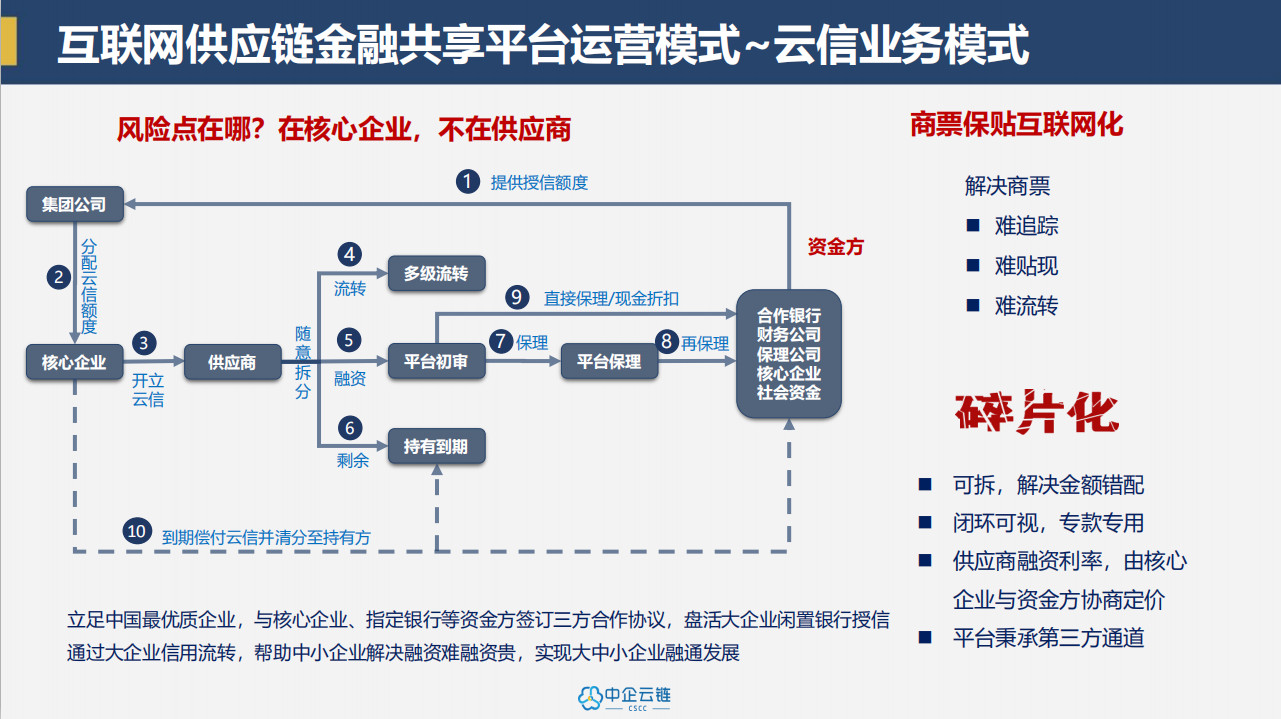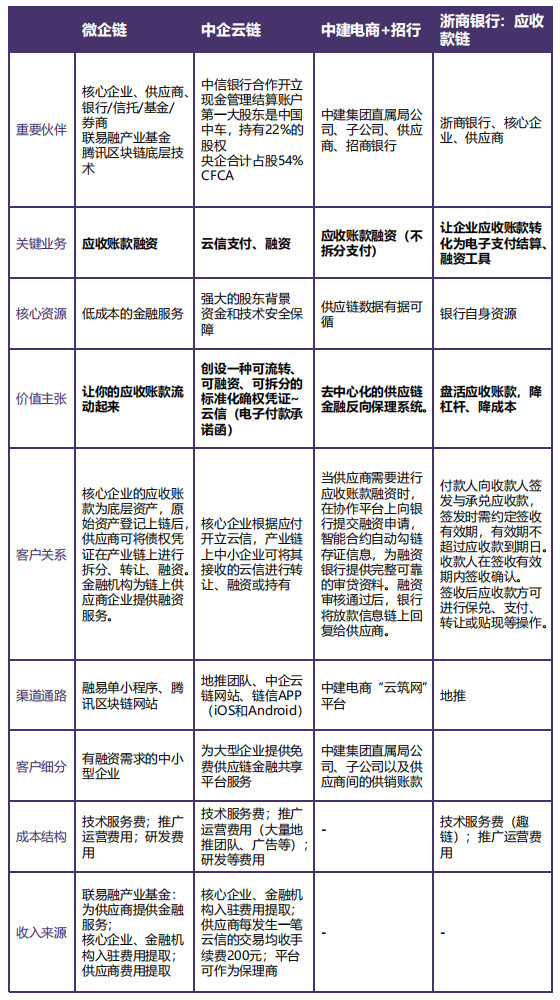Blockchain + Supply Chain Finance: Market Competitive Product Analysis
The business models and business processes of various types of blockchain + supply chain finance products are similar. The analysis of this article is mainly for the study of business models and commercial operations.

First, the industry background
Supply chain finance is a financing model in which banks connect core enterprises with upstream and downstream enterprises to provide flexible use of financial products and services. The upstream and downstream financing services of supply chain finance usually focus on the core enterprises.
Because core enterprises usually demand strict requirements on the pricing and account of upstream and downstream suppliers and distributors, SMEs in the supply chain often have tight capital and difficult turnover. To solve the problem of the difficulty in the circulation of funds for small and medium-sized enterprises, risk control is the biggest problem of the financial platform of the Internet supply chain. This has also led to the largest size of accounts receivable in the four types of financing: accounts receivable, prepaid, inventory financing and credit loans.
- HashQuark CEO Li Chen: Staking economy faces centralization risks, PoW+PoS is the mainstream
- Viewpoint | The most amazing passage in The Bitcoin Standard (below)
- Getting started with blockchain | Why hacking the trading platform without attacking Alipay?
The core pain points of traditional supply chain finance:
1. SMEs in the supply chain are difficult to raise and cost
The accounts payable assets of the core enterprises cannot be transferred step by step, and the factoring business cannot penetrate the entire supply chain. The second and third-level suppliers' funding needs are not met, leading to product quality problems.
2. The use of commercial ticket is limited, and the transfer is more difficult.
The use of trade tickets is subject to the credibility of the enterprise, and the time of discounting is difficult to control; the settlement agreement between suppliers lacks a systematic automatic trigger mechanism; in the multi-link supply chain financial business, the payment guarantee Lack of credible technical means.
3. Financial institutions have higher operational risks and costs
Financial institutions have higher operational and risk costs in terms of trade background verification, reliable pledge, and payment control, while enterprises or platforms in the trade chain are difficult to self-certify, and the costs, risks and benefits of financial institutions' supply chain financial services. More difficult to balance.
Second, the market size
According to iResearch's latest "2018 China Supply Chain Finance Industry Research Report", in China, industrial enterprises' accounts receivables already have a certain amount of volume , laying a foundation for the development of corresponding supply chain financing. However, the scale of supply chain financing is far less than the size of the basic accounts receivable financing.
According to the survey, the SME loan demand index continued to be greater than 50%, indicating that corporate financing needs continue to exist .

Third, determine the competing products
Blockchain technology is a distributed ledger technology with decentralized, non-tamperable, high security and intelligent contracts to ensure the integrity and reliability of information, and can effectively solve the trust and security problems in the transaction process.
1) The core enterprise confirms the assets on the blockchain, including the verification and confirmation of the true validity of the creditor's certificate. The characteristics of the blockchain can not be falsified to ensure that the credit certificate itself can not be falsified, prove the true validity of the transfer of the credit certificate, and can be split and transferred step by step to achieve the credit penetration of the core enterprise , thus solving the problem of financing difficulties of the supplier enterprises on the chain. .
2) The data on the chain can be traced back to the root source, saving a large number of financial institutions to adjust the human and material costs of the authenticity of the transaction information, and supplement the risk control system of the bank or Internet financial institution. Relying on the credit transfer of core enterprises, suppliers can enjoy faster and more efficient financing services and effectively solve the problem of financing difficulties.
3) In this trusting ecology, the core enterprise's credit can be transformed into online digital warrants, and the risk of compliance can be prevented through smart contracts , so that credit can be effectively transmitted along the supply chain, reducing cooperation costs and improving compliance efficiency. More importantly, when the digital warrants can be anchored in the chain, the smart contracts can also realize the splitting and circulation of funds from upstream and downstream enterprises, greatly improving the speed of funds and achieving automatic liquidation.
At present, many enterprises in China have started from the blockchain technology to lay out the supply chain financial market. We selected the following four competing products for analysis and analysis of blockchain + supply chain finance solutions.
- Micro-enterprise chain: As of the end of October 2018, the financing amount was nearly 30 billion yuan and the number of suppliers was nearly 3,000.
- China Enterprise Cloud Chain: 24,793 registered enterprises; opened 6 billion yuan of Yunxin; 36 billion yuan of factoring financing; accumulated transactions of 2016 billion yuan.
- China Construction E-Commerce + China Merchants Bank: 136 effective transactions; the total amount of financing is 205.6 million.
- Zheshang Bank “Accounts Receivable Chain Platform”: As of the end of June 2018, Zheshang Bank’s receivables chain platform has already radiated more than 1,800 enterprises, and has issued more than 2,600 receivables, totaling more than RMB 26 billion.
Fourth, the core function analysis of competing products
1. Micro-enterprise chain: let your accounts receivable flow

product description:
The micro-enterprise chain uses the accounts receivable from the core enterprises as the underlying assets, and realizes the transfer and splitting of the credit certificates through the blockchain technology of Tencent.
Among them, when the original assets are registered on the chain, the supplier's accounts receivable are audited and confirmed, and the trade relationship is confirmed to be true and effective, so as to ensure the authenticity of the assets on the chain. The creditor's certificate can be layered and transferred based on the supply chain. Each layer of circulation can completely trace the original assets of the registered chain to achieve the credit penetration of the core enterprise to the multi-level supplier.
Business Process:
- Core enterprise registration certification.
- Platform audit, bank credit approval quota.
- The core enterprise is connected to the micro enterprise chain system.
- The core company releases ABS/ABN requirements.
- Supplier registration certification.
- Submit the invoice + contract and apply for asset issuance.
- The micro-enterprise chain platform has a dedicated team for asset material review.
- After the approval, the core company will confirm the payment.
- After the core enterprise payment commitment is confirmed, the supplier can hold the credit certificate.
- The supplier can pay the voucher to the upstream settlement, or apply for factoring financing, or hold the expiration.
- After ABS/ABN expires, the payment is made according to the credit certificate.
risk control:
- The underlying assets are reviewed and screened by a senior professional team.
- Core business payment commitment.
- Bank credit support.
- Payment settlement is supported by Tencent Tenpay technical support and is implemented according to the agreement.
product experience:
The micro-enterprise chain has no specific operation interface to experience. The supplier's registration entry is a small program. The micro-enterprise chain official website / Lian Yirong official website is just leaving the "contact us" entrance. It is speculated that the platform is not open to the outside world, and it is necessary to cooperate with the target cooperative customers.
At present, the operation mode of the micro-enterprise chain is mainly to release ABS/ABN with Lianyi, and suppliers will issue assets on the platform and apply for financing. This model greatly reduces the financing costs of the entire industry chain.
2. China Enterprise Cloud Chain: Yunxin, the world is different for you

product description:
Yunxin is a corporate credit that flows on the Chinese enterprise cloud-chain platform. It is a large-scale enterprise group that transforms its high-quality enterprise credit into an innovative financial information service that can be transferred, financed and flexibly configured through the China Enterprise Cloud Chain Platform.
Business Process:
- Core enterprise registration certification.
- Platform audit, bank credit approval quota.
- Under the quota, the core enterprise opens a cloud letter based on the amount payable and promises to pay due.
- Supplier registration certification and opening a cash management settlement account.
- The supplier receives the cloud letter.
- The supplier can pay Yunxin to the upstream settlement, or apply for factoring financing (submit invoice + contract), or hold the expiration.
- The core company will pay the cloud letter and clear it to the holder.
risk control:
- Bank credit support.
- Core business payment commitment.
- CITIC Bank automatically 10,000-layer payment settlement.
product experience:
See the public number tweet "Cloud Chain Finance – User Operations Manual"
The propaganda of the China Enterprise Cloud Chain is mainly focused on the carrier of Yunxin, Yunxin = cash (free split) + commercial ticket (absolutely free) + silver ticket (high reliability) + easy traceability, well extracted "cloud The letter "as an advantage of a new type of electronic settlement tool. At the same time, the concept of blockchain is borrowed to prove the immutability and traceability of data.
From the dynamics of the WeChat public account of the China Enterprise Cloud Chain, the current cloud letter is being promoted across the country. According to Liu Jiang, chairman of the China Enterprise Cloud Network, there is currently a team of 200 people pushing the ground, and there will be 500 people next year. It is estimated that there are 5,000 core enterprises worthy of supply chain finance in the country. One person contacts ten enterprises, and 500 people seize these 5,000 core enterprises, which can basically cover the supply chain finance of China. Click to view.
3. China Construction E-Commerce + China Merchants Bank: Decentralized Supply Chain Financial Reverse Factoring System

product description:
After the China Construction Group's “Cloud Building Network” platform completes the bidding, signing, order and other procurement processes, the CSC suppliers can simultaneously deposit the supply and marketing data to the collaboration platform.
When the supplier needs to carry out the accounts receivable financing, the financing application is submitted to the bank on the collaborative platform, and the smart contract automatically links the deposit information to provide the financing bank with complete and reliable loan review information. After the financing review is passed, the bank will reply to the supplier on the loan information chain. After the financing expires, the supplier completes the financing repayment process through the collaboration platform.
Business Process:
- The effective financing business data and procurement data of the subsidiaries and subsidiaries of the China Construction Group directly under the chain are real-time.
- Supplier registration certification.
- Apply for accounts receivable financing.
- The platform automatically obtains corresponding trade data including orders, contracts, etc. according to accounts payable.
- The financing bank approved the loan after approval.
- The core company is due to pay directly to the bank.
risk control:
- Bank credit support (not mentioned, but should have)
- Core business payment commitment
- Procurement data on the blockchain confirms trade authenticity
- Core enterprise reverse factoring
product experience:
You can refer to the article "Joining Together" to build a new model of blockchain construction industry.
This product is different from the above products. The core enterprise it cooperates with is only for the companies and subsidiaries of the China Construction Group, and its financing services only serve the first-tier suppliers that directly trade with the core enterprises. The business model is based on The data on the chain is used as evidence for financing materials. At the same time, the data guaranteed by the blockchain is irresistible and difficult to tamper with, reducing financing risks.
4. Zheshang Bank's Receivables Chain Platform: Transforming accounts receivable into electronic payment settlement and financing tools

product description:
Application of blockchain technology, innovative development of the receivables chain platform, the transformation of corporate accounts receivable into electronic payment settlement and financing tools.
Business Process:
- The payer issues and accepts the receivables to the payee, and the validity period of the receipt must be agreed upon at the time of issuance, and the validity period does not exceed the due date of the receivable.
- The payee will sign and confirm during the validity period of the receipt.
- Receivables can be confirmed, paid, transferred or discounted after receipt.
- Receivables that have not been paid, transferred and discounted may be returned with the consent of the payee before the due date of the receivable.
risk control:
- Bank credit support
- Core business payment commitment
product experience:
Zheshang Bank launched the “Receivable Chain Platform” based on Hyperchain's underlying blockchain platform Hyperchain. The platform is an innovative financial technology product that uses blockchain technology to transform corporate accounts receivable into online payment and financing tools to help companies leverage and reduce costs. It is specially used for the issuance, acceptance, confirmation, payment, transfer, pledge and redemption of corporate accounts receivable.
V. Operation and commercialization
Here, we use commercial canvas to comprehensively analyze the commercialization model of competing products.

Conclusion
The business model and business process of blockchain + supply chain finance products are similar and easy to imitate.
In addition to the ones mentioned in this article, there are Bubbi blockchains, interesting chain traders/Western American chains, etc., but what can be done bigger and stronger is to fight for resources. This business model is destined to be led by the core companies with the highest bargaining power. How many core enterprise resources can you introduce? Whether the core enterprise is large enough depends on the business capabilities of your platform.
This competition product analysis is mainly to study the business model and commercial operation. In fact, the water is still very deep. It is not a simple flow chart + capital flow, so you can copy the business model of others.
Currently still learning and exploring, welcome all the great gods to criticize and correct!
Source: Everyone is a product manager
Author: small products
We will continue to update Blocking; if you have any questions or suggestions, please contact us!
Was this article helpful?
93 out of 132 found this helpful
Related articles
- The hacker is keeping a close eye on the currency exchange: 5 were killed and 8 were "Lai Lai"
- In-depth analysis of the collapse of the currency security: block reorganization, the only beneficiary is only miners!
- Market analysis on May 9th: Will the resonance mode cause the BTC to rise for a few days?
- Market Analysis: Multiple favorable blessings will enter the bull market?
- 8 most common misconceptions about blockchain
- Babbitt Accelerator Technology Open Class | Storj solves distributed cloud storage data problem with erasure code
- Babbitt column | Blockchain + Energy: A short-lived collision?






